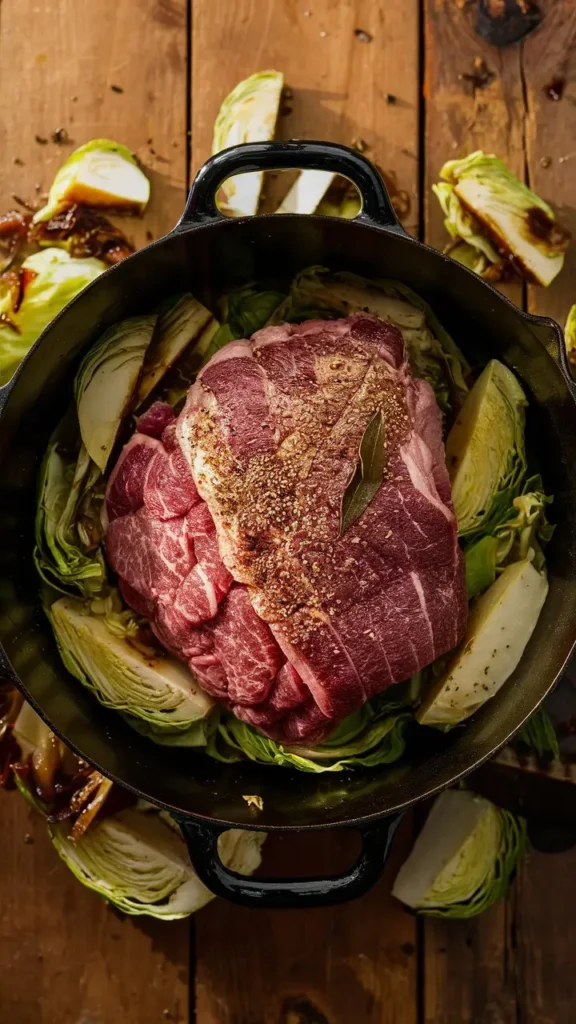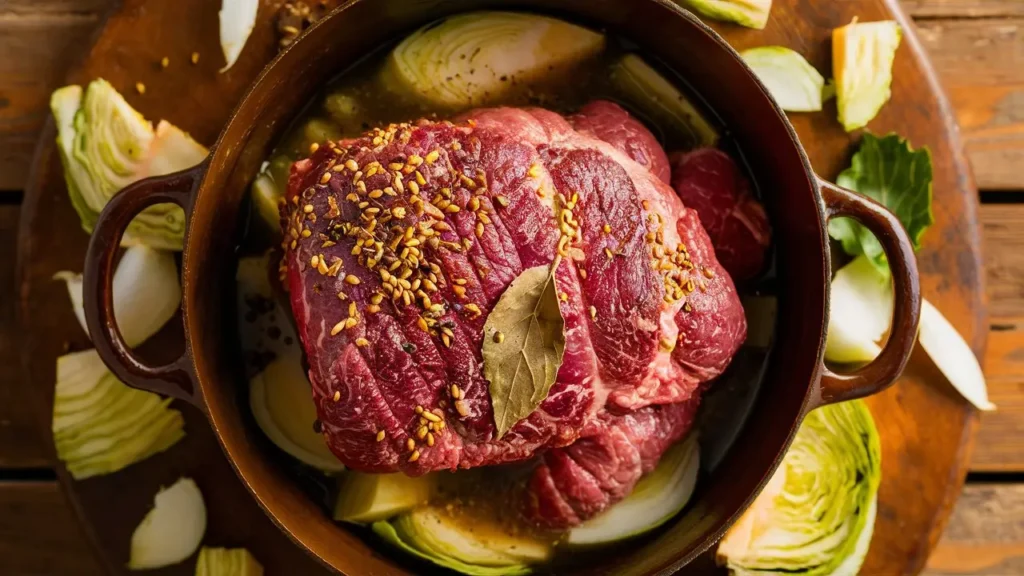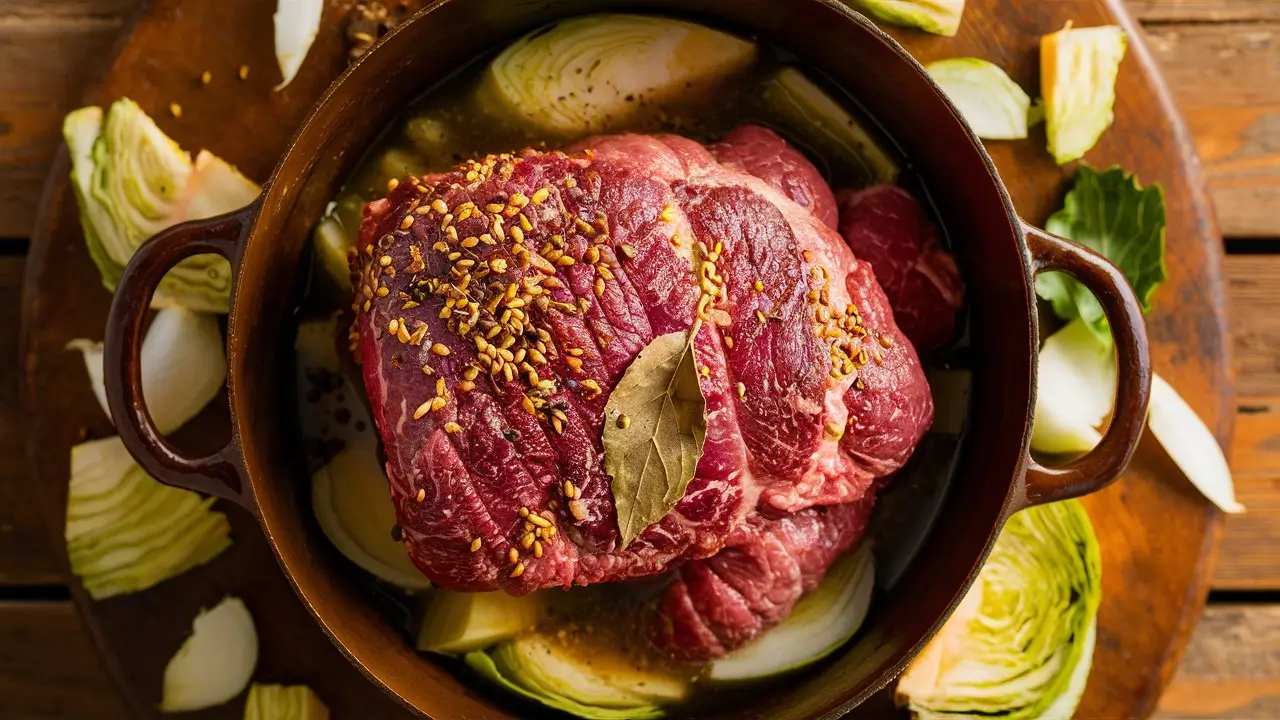Corned beef and cabbage recipe is a classic comfort food often associated with Irish-American traditions, especially around St. Patrick’s Day. However, this flavorful, hearty meal is perfect year-round, thanks to its simple ingredients and rich, satisfying taste. Whether you’re cooking it for a holiday feast or a comforting Sunday dinner, this dish never fails to impress.
In this guide, you’ll learn everything from selecting the right cut of meat to customizing your veggies and maximizing flavor. Get ready to master the art of corned beef and cabbage.

Why You Will Love This Recipe
-
Traditional and Comforting – A meal steeped in heritage that’s rich, filling, and soul-warming.
-
Simple Ingredients – Uses everyday vegetables and pantry staples.
-
Great for Leftovers – The meat and veggies taste even better the next day.
-
Perfect for Celebrations – Ideal for family gatherings, holiday dinners, or potlucks.
Ingredients List
Here’s what you’ll need for a complete corned beef and cabbage dinner:
-
3 to 4 pounds corned beef brisket (with spice packet)
-
10 cups water or low-sodium beef broth
-
1 large onion, quartered
-
3 cloves garlic, smashed
-
1 bay leaf
-
1 teaspoon black peppercorns
-
4 large carrots, cut into 2-inch chunks
-
4 large potatoes (Yukon Gold or red), quartered
-
1 small head green cabbage, cut into wedges
-
Optional: 2 tablespoons apple cider vinegar or whole-grain mustard (for added flavor)
Timing & Servings
-
Prep Time: 15 minutes
-
Cook Time: 3–4 hours (depending on method)
-
Total Time: 4 hours
-
Servings: 6–8
Step-by-Step Instructions for Corned Beef and Cabbage Recipe
Step 1: Prepare the Corned Beef
Rinse the corned beef under cold water to remove excess salt from the packaging brine. Place it in a large stockpot or Dutch oven, fat side up.
Step 2: Add Aromatics and Liquid
Add the quartered onion, garlic, bay leaf, peppercorns, and spice packet that came with the brisket. Pour in enough water or beef broth to completely cover the meat.
Step 3: Simmer Slowly
Bring to a gentle boil over medium-high heat. Once boiling, reduce heat to low, cover the pot, and simmer for about 2.5 to 3 hours, or until the beef is fork-tender.
Step 4: Add Root Vegetables
Add carrots and potatoes into the pot. Simmer for 20 minutes.
Step 5: Add Cabbage
Add the cabbage wedges and cook for another 15–20 minutes until the cabbage is tender but not mushy.
Step 6: Rest and Slice the Meat
Remove the corned beef from the pot and let it rest for 10 minutes before slicing. Always slice against the grain for tenderness.
Step 7: Serve
Plate sliced beef with the cooked vegetables. Ladle a little cooking broth over the top for added moisture and flavor.

Alternative Cooking Methods
Slow Cooker Method
Place corned beef, seasoning, onion, and broth in a slow cooker. Cook on low for 8 hours. Add carrots and potatoes in the last 2 hours. Add cabbage in the final 30–45 minutes.
Instant Pot Method
Use the pressure cook setting for 90 minutes for a 3-pound brisket with the liquid and aromatics. Naturally release for 15 minutes, then add veggies and cook for another 5–10 minutes under pressure.
Tips for Best Results
-
Rinse the Brisket: This removes excess salt and helps control the final flavor.
-
Low and Slow: Simmer gently to ensure the beef stays tender and juicy.
-
Slice Against the Grain: This breaks up the meat fibers and gives you a more tender bite.
-
Add Cabbage Last: Overcooked cabbage becomes mushy and unpleasant.
Flavor Variations
Beer-Braised Corned Beef
Replace half of the broth or water with a bottle of Irish stout or amber ale for a deeper, more robust flavor.
Glazed Finish
After boiling, brush the beef with a mix of brown sugar and Dijon mustard, then broil for 5 minutes for a caramelized crust.
Garlic and Herb Boost
Add fresh thyme, rosemary, or extra garlic for a more herbaceous profile.
What to Serve with Corned Beef and Cabbage
-
Horseradish Sauce: Creamy and spicy, it pairs well with the richness of the beef.
-
Irish Soda Bread: A traditional side that complements the hearty meal.
-
Pickled Beets: The acidity cuts through the fat and brightens the plate.
-
Grainy Mustard: A dollop on the side enhances the meat’s flavor.
Leftover Ideas
Corned beef and cabbage leftovers are just as versatile as they are delicious:
Corned Beef Hash
Dice the meat and potatoes, then pan-fry with onions and peppers for a savory breakfast.
Reuben Sandwich
Layer slices of leftover corned beef with Swiss cheese, sauerkraut, and Russian dressing on rye bread. Grill until crispy.
Soup or Stew
Chop leftover beef and veggies, then simmer in broth for a hearty soup.
Nutritional Overview (Per Serving)
Estimated based on 6 servings.
-
Calories: 480
-
Protein: 38g
-
Fat: 25g
-
Carbohydrates: 24g
-
Fiber: 5g
-
Sodium: 1400mg (depends on rinsing and brand)
Make-Ahead and Storage
Make-Ahead
Cook the corned beef a day ahead for deeper flavor. Refrigerate overnight and reheat gently with a splash of broth.
Storage
-
Refrigerator: Store leftovers in an airtight container for up to 4 days.
-
Freezer: Corned beef freezes well. Slice, wrap, and freeze for up to 2 months.
FAQs
Is corned beef actually Irish?
Corned beef and cabbage is more of an Irish-American dish. In Ireland, pork was more common historically, but Irish immigrants in the U.S. adopted beef brisket as a substitute.
Can I use red cabbage instead?
Yes, though red cabbage will slightly discolor the broth and other ingredients. Flavor-wise, it’s perfectly fine.
What’s the best cut for corned beef?
Brisket is the traditional cut. Flat cut is leaner and easier to slice, while point cut is more marbled and flavorful.
How do I know when it’s done?
The beef should be fork-tender. You can also use a meat thermometer—internal temp should be around 190°F (88°C) for shredding.
Conclusion
Corned beef and cabbage recipe is a classic for good reason. With tender, flavorful meat, hearty vegetables, and a rich, comforting broth, it’s the kind of dish that brings people together around the table. Whether you’re making it for a St. Patrick’s Day celebration or a cozy Sunday dinner, this recipe guarantees satisfying results every time.
From traditional stovetop methods to modern slow cooker and Instant Pot variations, there’s a cooking method that fits your lifestyle. And the best part? The leftovers are almost as delicious as the original meal.
